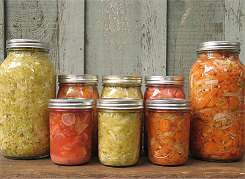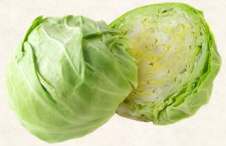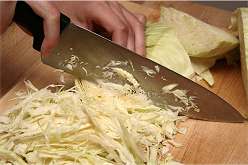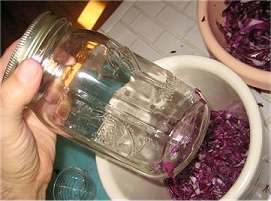|
Charis
Cuisine
Making Sauerkraut
nutritional
benefits of fermented foods
By
Susan Oshel

Fermented foods are so nutritionally beneficial and safely
stored for such long periods of time, they are commonly used
around the world in areas where malnutrition is prevalent.
They're easier to digest and more nutritious. During time
of food shortage, things that are not normally eaten can be
fermented to make them more palatable. The strong taste of
fermented foods is useful in adding flavor to diets that might
otherwise be bland. Wild fermentation involves creating
conditions in which naturally occurring organisms thrive and
proliferate.
A variety of foods can be fermented. This includes
beverages (such as Kombucha), fruits, vegetables and grains.
Once fermented, these foods can be used as condiments, sauces,
seasonings, side dishes or ingredients in main dishes.
Foods contaminated with certain types of bacteria can cause
diarrhea, which can lead to malnutrition. Fermenting foods
creates conditions that are unfriendly for these types of
bacteria, killing unfriendly types and keeping others from
contaminating these foods, making fermented foods less likely to
cause food-borne illnesses. These foods also have friendly
bacteria, or probiotics, which help to prevent these types of
infections. These nutrients help to bolster the immune
system against other illnesses as well.
One
of the awesomely wonderful fermented foods is: sauerkraut! It's
so easy and fun to make that there's really no good
excuse to buy it from a store. Plus, home made sauerkraut
is full of living microbes that are good for you.
Be aware that
store bought sauerkraut is often not fermented -- it's just
cabbage soaked in salty vinegar. Even store bought
brands of sauerkraut made from lacto-fermentation have usually
been cooked to the point that they're no longer alive.
Making your own is easy and wonderful!!
References
United Nations University: The Benefits of Traditional Fermented
Foods
Eden Foundation: Fermented Food -- Safer to Eat
Food and Agriculture Organization: The Benefits of Fermenting
Fruits and Vegetables
American Journal of Clinical Nutrition: Probiotic Bacteria in
Fermented Foods: Product Characteristics and Starter Organisms
Recipe
to make Sauerkraut
Making Sauerkraut is Easy!

I
make a 2-quart batch of sauerkraut from one head of cabbage.
Following are pictures from two different batches, one from red
cabbage, one was green cabbage, both are great, and you can even
use both in one batch.
Tools
and ingredients:
Sharp knife
1/2-gallon stoneware fermenting crock
wooden lid for 1/2-gallon crock (I use a plate that fits
perfectly inside the crock)
scrubbed and boiled rock to weigh down wooden lid (or plate)
large bowl
cutting board
something to mash the cabbage down into the crock (I use a
1-quart mason jar, you can use your fist if you want)
1 head of cabbage (2 1/2 lbs)
salt (sea or kosher)
You don't need to buy a starter culture -- there are lactic acid
bacteria floating around in the air ready to go to work on the
cabbage. I find that amazing.
Steps:
1. Chop or grate cabbage, finely or coarsely, with or without
hearts, however you like it. Put a handful in the bowl,
sprinkle salt on the cabbage as you go. Stir it up and
repeat. The salt pulls water out of the cabbage (through
osmosis), and this creates the brine in which the cabbage can
ferment and sour without rotting. The salt also has the
effect of keeping the cabbage crunchy, by inhibiting organisms
and enzymes that soften it. I never measure the salt;
I just sprinkle it on after every handful of chopped cabbage is
placed in the bowl. Use more salt in summer, less in
winter.

You can add other vegetables. Grate carrots for a
coleslaw-like kraut. Other vegetables you can add include
onions, garlic, seaweed, greens, turnips, beets, and burdock
roots. You can also add fruits (apples, whole or sliced,
are classic), and herbs and spices (caraway seeds, dill seeds,
celery seeds, and juniper berries are classic, but anything you
like will work.) Experiment.
2.
Put the salted cabbage (or vegetable mix) into the crock one
handful at a time, mashing it down as you go along. It's
important to pack it as tightly as you can, because that
way the salt will draw out the water from the cabbage so
fermentation can occur.

3. When all the cabbage (or other vegetables) have been packed
into the crock, put the wood cover on it. If you don't
have a wooden cover, try a plate that fits. Pack just a bit into the crock at a
time and tamp it down hard using your fists or any (other)
sturdy kitchen implement. (I use a mason jar, works like
a charm!) The tamping packs the kraut tight in the crock and
helps force water out of the cabbage.
4. Put a rock on top of the cover. The idea is to keep the
sauerkraut submerged under the brine, because lacto-fermentation
is anaerobic. If the cabbage is exposed to the air, the
fermentation process will be stunted. Cover it with a
cloth and put the crock somewhere out of the way. Once or
twice a day, push on the rock to smash the cabbage down.
This weight is to force water out of the cabbage and then keep
the cabbage submerged under the brine.

Allow it to ferment for up to 2-4 weeks, removing the rock and
pressing the plate firmly down twice a day, squeezing water up a
little at a time, replacing the rock.
Check the kraut every day or two. The volume reduces as
the fermentation proceeds. The kraut itself is under
the anaerobic protection of the brine. Rinse off the plate
and the weight. Taste the kraut. Generally it starts
to be tangy after a few days, and the taste gets stronger as
time passes. In the cool temperatures of a cellar in
winter, kraut can keep improving for months and months. In
the summer or in a heated room, its life cycle is more rapid.
I have some at least once a day, it's delicious!!!
I
generally scoop out a bowlful at a time and keep it in the
fridge after 4 weeks of fermentation. Start when the
kraut is young and enjoy its evolving flavor over the course of
a few weeks. Try the sauerkraut juice that will be left in
the bowl after the kraut is eaten. Sauerkraut juice is a
rare delicacy and unparalleled digestive tonic. (One
group of Amish ladies I know uses sauerkraut juice in the first
trimester and highly affirms that it reduces morning sickness
when nothing else would for them.)
Each
time you scoop some kraut out of the crock, you have to repack
it carefully. Make sure the kraut is packed tight in the
crock, the surface is level, and the cover and weight are clean.
Sometimes brine evaporates, so if the kraut is not submerged
below brine just add salted water as necessary. Some
people preserve kraut by canning and heat-processing it.
This can be done; but so much of the power of sauerkraut is its
aliveness and heating it will kill it!
Enjoy!!
|